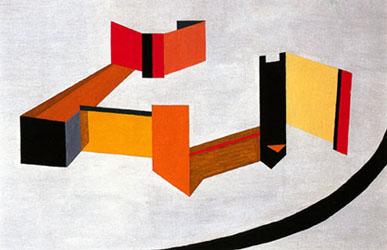The Park Avenue Cubists
dal 13/1/2003 al 29/3/2003
Segnalato da
13/1/2003
The Park Avenue Cubists
Grey Art Gallery, New York
American abstract painting in 1930s and '40s. The first major museum exhibition devoted entirely to the work of four artists - A.E. Gallatin, George L.K. Morris, Suzy Frelinghuysen, and Charles G. Shaw -. The Park Avenue Cubists features some 50 paintings.

Gallatin, Morris, Frelinghuysen, And Shaw
From Paris to Park Avenue...Grey Art Gallery exhibition explores
American abstract painting in 1930s and '40s
Dapper and discerning, 'the Park Avenue Cubists' were committed artists as well as passionate patrons. The first major museum exhibition devoted entirely to the work of four artists-A.E. Gallatin, George L.K. Morris, Suzy Frelinghuysen, and Charles G. Shaw-The Park Avenue Cubists features some 50 paintings and is on view at the Grey Art Gallery from January 14 to March 29, 2003. These Cubist-inspired paintings reveal the artists' ardent commitment to perpetuating the European origins of modernism while also formulating one of the first reductivist abstract languages of art in the United States.
Gallatin, Morris, Frelinghuysen, and Shaw were dubbed 'the Park Avenue Cubists' by fellow members of the American Abstract Artists (AAA) group. The four friends shared privileged and pampered backgrounds, providing fodder for the insouciant sobriquet. In their quest to create a truly American strain of modern art, they melded the stylistic lessons of Cubism and its derivations with indigenous American subject matter, from Hopi kachinas to Manhattan cityscapes.
All four had been inspired by the work of Braque, Picasso, Gris, and Léger, which they had witnessed firsthand during repeated trips to Paris, and they considered themselves the legitimate aesthetic heirs to avant-garde French culture. Erudite and cosmopolitan, they published widely on the aesthetic ideals of the European modernists whose work they collected. Also included in the show are portraits of the artists and publications by them.
In their appropriation of popular imagery from billboards and advertising logos, they not only looked back to Analytic Cubism's incorporation of bits of newspaper and other ephemera, but also ahead to the work of Pop artists. Guest curator Debra Bricker Balken observes, 'Ironically, the issue of originality, which has come under fire in the past two decades or so, allows us to look afresh at both the Park Avenue Cubists and the AAA. The work of Gallatin, Morris, Frelinghuysen and Shaw, however, perpetuated rather than undermined the foundations of modernism. They borrowed unashamedly to create their accomplished and ingenious works of art.'
A.E. Gallatin was the great-grandson of Albert Gallatin, who was Secretary of the U.S. Treasury under Presidents Jefferson and Madison and the founder of New York University. In 1927, A.E.Gallatin established the Gallery of Living Art in NYU's Main Building on Washington Square East.
He conceived his gallery as a 'laboratory' where artists and others could study the latest artistic currents from Paris. Indeed, the collection stirred innumerable New York artists, including Gallatin, who, in 1936, began painting abstract, geometric canvases inspired by Picasso, Braque, and Gris, as well as by the 'second generation' Cubists Léger and Gleizes.
George L.K. Morris, a wealthy painter, collector, and ideologue, became the first curator of the Gallery of Living Art (later renamed the Museum of Living Art). The first art critic for Partisan Review, Morris championed American abstraction. Suzy Frelinghuysen, Morris's wife, created a semi-abstract style derived from Cubist collages and performed as a professional opera singer. The couple shared a modernist house co-designed by Morris and architect John Butler Swann which included frescoes painted by Morris and Frelinghuysen. Built as a summer home in Lenox, Massachusetts, the Le Corbusier-inspired structure shocked their conservative neighbors. Shaw, on the other hand, pursued a completely 'concrete,' or non-objective idiom. In a number of works he even shaped his canvases to mimic the stepped geometric contours of Manhattan skyscrapers.
'It is especially fitting that NYU's Grey Art Gallery present this exhibition. Not only was A.E. Gallatin a direct descendant of Albert Gallatin, who founded New York University in 1831, but the Grey Art Gallery occupies the very same space as the Museum of Living Art, which built on Greenwich Village's impressive artistic heritage,' notes Lynn Gumpert, Director of the Grey Art Gallery. 'Indeed, the Museum of Living Art provided a space where artists such as Willem de Kooning and Hans Hofmann, as well as students and Greenwich Village residents, came to puzzle through the myriad and complex issues of Cubism, and to keep abreast of new developments in abstraction.'
The Park Avenue Cubists is accompanied by a fully illustrated book published by Ashgate Ltd. with essays by Balken and Robert S. Lubar, Associate Professor of Modern Art History at the Institute of Fine Arts, New York University. The exhibition will also travel to the Addison Gallery of American Art at Phillips Academy, Andover, Massachusetts, April 22x{2013}July 31, 2003, and to the Harn Museum of Art, University of Florida, Gainesville, September 2x{2013}November 30, 2003.
The exhibition is made possible by The Henry Luce Foundation, Inc., and the National Endowment for the Arts. The Grey Art Gallery presentation is supported in part by the Abby Weed Grey Trust.
Image: Albert Eugene Gallatin, Kenilworth Castle - Aerial View, 1940
Oil on canvas, 10 x 16 inches, Collection of David and Lynne Anderson
Grey Art Gallery
100 Washington Square East, New York University
New York



